Themed collection JMC B Top Picks web collection: Seeing the unseen: Advances in bioimaging and biosensors

Journal of Materials Chemistry B top picks web collection: “seeing the unseen: advances in bioimaging and biosensors”
Xiaogang Qu introduces a Journal of Materials Chemistry B Top Picks web collection on advances in bioimaging and biosensors.

J. Mater. Chem. B, 2016,4, 4500-4501
https://doi.org/10.1039/C6TB90078J
Ultra-small fluorescent inorganic nanoparticles for bioimaging
The recent advances of ultra-small fluorescence inorganic nanoparticles including quantum dots, metal nanoclusters, carbon and graphene dots, up-conversion nanocrystals, and silicon nanoparticles have been comprehensively reviewed.
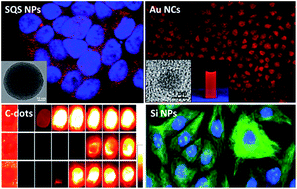
J. Mater. Chem. B, 2014,2, 2793-2818
https://doi.org/10.1039/C3TB21760D
NIR luminescent nanomaterials for biomedical imaging
We review the recent progress in near-infrared nanomaterials from fabrication to application in biomedical imaging.

J. Mater. Chem. B, 2014,2, 2422-2443
https://doi.org/10.1039/C3TB21447H
Gold–graphene nanocomposites for sensing and biomedical applications
Recent developments in materials science and nanotechnology have propelled the development of a plethora of materials with unique chemical and physical properties for biomedical applications.

J. Mater. Chem. B, 2015,3, 4301-4324
https://doi.org/10.1039/C5TB00511F
A novel aptameric nanobiosensor based on the self-assembled DNA–MoS2 nanosheet architecture for biomolecule detection
A novel fluorescence-activated nanobiosensor for detecting biomolecular targets such as proteins and small molecules based on the self-assembled architecture of an aptamer–MoS2 nanosheet.

J. Mater. Chem. B, 2014,2, 625-628
https://doi.org/10.1039/C3TB21570A
Electrospinning graphene quantum dots into a nanofibrous membrane for dual-purpose fluorescent and electrochemical biosensors
An electrospinning technique was utilized to add graphene quantum dots into a nanofibrous polymer membrane for dual-purpose fluorescent and electrochemical biosensors.
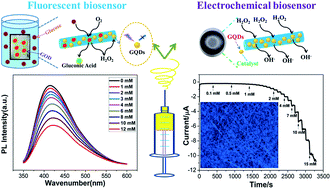
J. Mater. Chem. B, 2015,3, 2487-2496
https://doi.org/10.1039/C4TB02092H
Multiwalled carbon nanotube@reduced graphene oxide nanoribbon heterostructure: synthesis, intrinsic peroxidase-like catalytic activity, and its application in colorimetric biosensing
The MWCNT@rGONR core–shell heterostructure was proved to be a novel peroxidase mimetic and has been used for colorimetric biosensing of cholesterol.

J. Mater. Chem. B, 2015,3, 1624-1632
https://doi.org/10.1039/C4TB01702A
Dual-functional carbon dots–silver@zinc oxide nanocomposite: in vitro evaluation of cellular uptake and induction of apoptosis
We report here the devleopment of novel CDs decorated on a silver–zinc oxide (CD–Ag@ZnO) nanocomposite (NC) consisting of highly fluorescent CDs and Ag@ZnO.

J. Mater. Chem. B, 2015,3, 1217-1229
https://doi.org/10.1039/C4TB02043J
Application of paramagnetic graphene quantum dots as a platform for simultaneous dual-modality bioimaging and tumor-targeted drug delivery
This paper reports the development of a multifunctional nanocarrier platform consisting of paramagnetic graphene quantum dots, folate, and doxorubicin for simultaneous fluorescence and MR imaging, and cancer treatment.

J. Mater. Chem. B, 2015,3, 651-664
https://doi.org/10.1039/C4TB01650E
Designed self-assembled hybrid Au@CdS core–shell nanoparticles with negative charge and their application as highly selective biosensors
Schematic illustration of the reaction mechanism of Au@CdS core–shell structure with DA in the presence of UA and AA.

J. Mater. Chem. B, 2015,3, 217-224
https://doi.org/10.1039/C4TB01713G
Multifunctional water-soluble luminescent carbon dots for imaging and Hg2+ sensing
We propose an ingenious method for large-scale fabrication of water-soluble photoluminescent carbon dots (CDs) by a one-step microwave route in the presence of citric acid and ethylenediamine.

J. Mater. Chem. B, 2014,2, 6995-6999
https://doi.org/10.1039/C4TB01035C
Quinoline derivative-functionalized carbon dots as a fluorescent nanosensor for sensing and intracellular imaging of Zn2+
Functionalization of carbon nanodots (C-dots) with quinoline derivatives enables a highly sensitive and specific nanosensor for Zn2+ sensing in aqueous solution and Zn2+ imaging in vivo.

J. Mater. Chem. B, 2014,2, 5020-5027
https://doi.org/10.1039/C4TB00677A
Green synthesis of nitrogen-doped carbon dots from konjac flour with “off–on” fluorescence by Fe3+ and L-lysine for bioimaging
The N-CDs are synthesized by pyrolysis of konjac flour and show “off–on” fluorescence by mixing with Fe3+ and L-lysine.

J. Mater. Chem. B, 2014,2, 4631-4639
https://doi.org/10.1039/C4TB00368C
Cyclometalated Ir(III) complexes with styryl-BODIPY ligands showing near IR absorption/emission: preparation, study of photophysical properties and application as photodynamic/luminescence imaging materials
Heteroleptic C^N cyclometalated iridium(III) complexes showing strong NIR absorption were prepared.

J. Mater. Chem. B, 2014,2, 2838-2854
https://doi.org/10.1039/C4TB00284A
A facile biofunctionalisation route for solution processable conducting polymer devices
For the majority of biosensors or biomedical devices, immobilization of the biorecognition element is a critical step for device function.
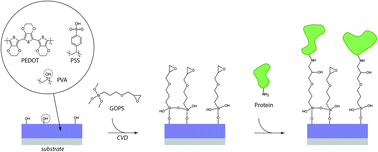
J. Mater. Chem. B, 2014,2, 2537-2545
https://doi.org/10.1039/C3TB21491E
A dual-mode fluorescence “turn-on” biosensor based on an aggregation-induced emission luminogen
A dual-mode fluorescent biosensor based on TPE-TEG-PA is developed for protamine quantification and alkaline phosphatase activity assay.

J. Mater. Chem. B, 2014,2, 1717-1723
https://doi.org/10.1039/C3TB21576H
Graphitic-phase C3N4 nanosheets as efficient photosensitizers and pH-responsive drug nanocarriers for cancer imaging and therapy
We demonstrate that g-C3N4 nanosheets with excellent biocompatibility can be employed as photosensitizers and drug nanocarriers for cancer imaging and therapy.

J. Mater. Chem. B, 2014,2, 1031-1037
https://doi.org/10.1039/C3TB21479F
Preparation of core–shell Fe3O4@poly(dopamine) magnetic nanoparticles for biosensor construction
Schematic illustration of the synthesis of core–shell Fe3O4@pDA/HRP nanoparticles and the construction of the Fe3O4@pDA/HRP-modified GC electrode.

J. Mater. Chem. B, 2014,2, 739-746
https://doi.org/10.1039/C3TB21171A
The fabrication and characterization of Cu-nanoparticle immobilization on a hybrid chitosan derivative-carbon support as a novel electrochemical sensor: application for the sensitive enzymeless oxidation of glucose and reduction of hydrogen peroxide
New hybrid chitosan derivative-copper nanoparticles-modified carbon nanotubes as electrocatalyst for glucose oxidation and H2O2 reduction.
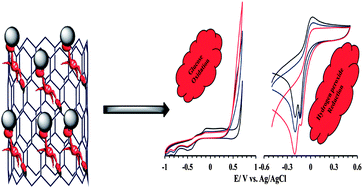
J. Mater. Chem. B, 2014,2, 706-717
https://doi.org/10.1039/C3TB21434F
Bifunctional up-converting lanthanide nanoparticles for selective in vitro imaging and inhibition of cyclin D as anti-cancer agents
Inhibition of the CDK4/cyclin D complex through the substrate recruitment site on the cyclin positive regulatory subunit is recognised as being a promising anti-cancer target.
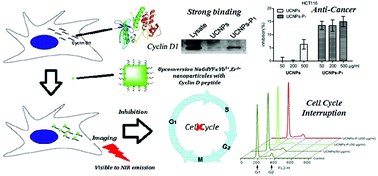
J. Mater. Chem. B, 2014,2, 84-91
https://doi.org/10.1039/C3TB21034K
About this collection
This first in a series of JMC B Top Picks web collections focusses on the recent advances in bioimaging and biosensors.
Journal of Material Chemistry B’s Associate Editor Xiaogang Qu (Chinese Academy of Sciences, CIAC, China) has gathered together the journal’s most outstanding recent papers on biosensors and bioimaging with crucial real world applications such as the early detection and prognosis of diseases and healthcare via visualization, characterization, and monitoring of important biological events.
Browse this collection to view reviews and original research demonstrating the unparalleled potential in personalized treatment, early detection, point-of-care, and accurate diagnoses and the many interesting results published in this exciting field. This Top Picks web collection entitled “Seeing the unseen: Advances in bioimaging and biosensors” highlights Journal of Materials Chemistry B’s most outstanding papers in functional materials-based bioimaging and biosensing and their applications in early detection and prognosis of diseases and healthcare.